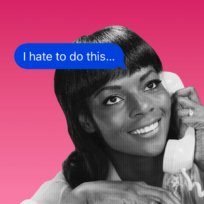Nicole Moore co-founded The Center Method (TCM), a one-stop studio for mind body self-care. As a certified Clinical Psychologist and licensed yoga instructor trained in Vinyasa, Sculpt, and Yoga Bar, Moore has created an all-encompassing wellness center and community to bring personal development and health under one roof. Through the combination of psychotherapy, bodywork, body movement/awareness, mindfulness, yoga and meditation, Moore has made it her mission to help bring people of all ages find human resiliency from within.
As someone who has suffered from anxiety and anxiety attacks, I know how scary and uncomfortable the stress response can feel in the body. We feel anxiety when the “fight or flight response” (a physiological reaction that occurs in response to a real or imagined threat to survival) is activated. The “attack” affects the sympathetic nervous system, which is responsible for the involuntary responses including heart palpitations, tightness in the chest, lightheadedness, and feelings of being flushed or warmer than usual. As you perceive a threat, the amygdala (often referred to as the “lizard brain” or “reptilian brain”) tells your autonomic nervous system to prepare to run or fight for your life. Your heart rate and breathing quicken, and your “spidey senses” (the ability to sense imminent danger) activate. The parasympathetic nervous system is what slows the fight or flight response and activates your body’s “relaxation response”, which is essentially the exact opposite reaction to the “fight or flight” response. It is your conscious ability to encourage your body to release signals to the brain that slow your muscles and organs down and increase blood flow to the brain, which produces a calm, relaxed feeling in the mind and body. There are many techniques you can learn to switch on the parasympathetic nervous system to rapidly reduce feelings of anxiety and stress. Here are my go-to approaches to address the symptoms of an anxiety attack.
1. Boxing

The challenge many of us face in the midst of an anxiety attack is the struggle to reestablish control of our body and mind. Physical activities that lead to a greater sense of self-mastery (e.g. martial arts, boxing) may affect your belief in your ability to reach goals and self-efficacy. This leads to lower levels of anxiety through the trust and knowledge of your physical ability to handle potential threats, real or imagined. Boxing requires focus to coordinate the mind and body, which brings you into the present moment and distracts the mind from ruminating thoughts. Boxing builds self-confidence and self-esteem through a sense of achievement. Added benefits of going to a boxing gym can include finding a community and a sense of belonging.
2. Yoga

Yoga is a 5,000-year-old moving meditation that elicits the relaxation response through the synchronization of breath and movement. Breathing is the only function of the autonomic nervous system that is both voluntary and involuntary; controlled breathing can regulate the stress response. Yoga is a systematic practice of movements developed to evoke harmony in the mind and body. A few yoga poses that calm the nervous system are:
- Seated forward fold (Paschimottanasana), which reduces anxiety and quiets the mind by drawing your energy down.
- Expanded-Leg Pose (Prasarita Padottanasana), which brings fresh blood to the brain, allows the heart to rest, and calms the mind.
- Forward-fold (Uttanasana), which stimulates blood flow to the brain and calms the nervous system.
- Cross-legged pose (Sukhasana), which provides a stable position for meditation, and calms and settles the mind.
3. Dance

Dance…like no one is watching. If you’re in the midst of an anxiety attack, or feel the tingles of anxiety seeping through, turn on some upbeat music and move your body! Not only does this release body tension, but it also helps shift your focus from worrisome thoughts to being in the present moment. Dance can quickly influence emotions, mood, and attitude because of the intrinsic relationship between the body and mind—what happens to the body can affect the mind and vice versa.
4. Walking

Walking (and other exercise) triggers the release of endorphins, which creates a positive feeling in the body. To help ease the psychological pain and discomfort associated with anxiety, take a break, and put physical and mental distance between you and the environment which may be adding to the stress. Anxiety is fear of the future; walking helps get you outside of your thoughts to bring your focus back to the here and now. Studies show that walking in nature can be beneficial for stress and anxiety relief, but even if you live in an urban environment, a 15-minute walk may be just the thing you need to get your mind off the worry. Focus on the present moment by observing the environment around you: enjoy the fresh air, notice the sound of your feet as you walk along, window shop, listen to the birds, feel the breeze on your face, etc.
Bonus: Four Square Breathing

It’s not an exercise, but nonetheless it’s an important technique that can work. Four Square Breathing can be used when you need to quickly cool down the mind and body. Intentional deep breathing calms and regulates the autonomic nervous system with immediate results. It also focuses your energy on the task at hand to minimize rumination and brings your awareness into the present moment. Here’s how:
To begin, exhale all the air in your lungs.
- Inhale deeply through the nose for the count of one, two, three, four.
- Hold the breath for one, two, three, four.
- Exhale through the mouth for one, two, three, four.
- Pause at the bottom for one, two, three, four.
Repeat the cycle four times.
I’ve been lucky to experience the grounding, calming and refocusing effects of practicing each of the aforementioned exercises. While these activities have greatly helped me to reduce and control anxiety, and I recommend trying each of them due to their proven benefits, it is most important to find the form of physical exercise or mental practice that best aids you personally in overcoming general anxiety as well as anxiety attacks. Though it can be an arduous path to finding what form of relief best suits your needs, it is worth investing the time and energy to safeguard your emotional health.
Images: Form / Unsplash; Giphy (5)



















































